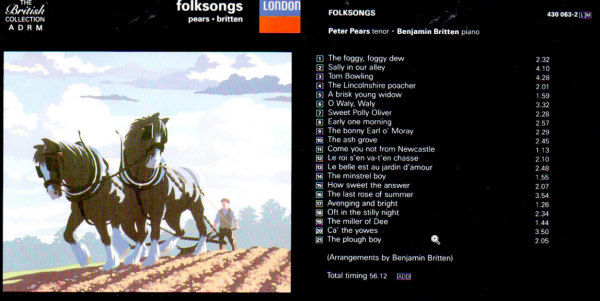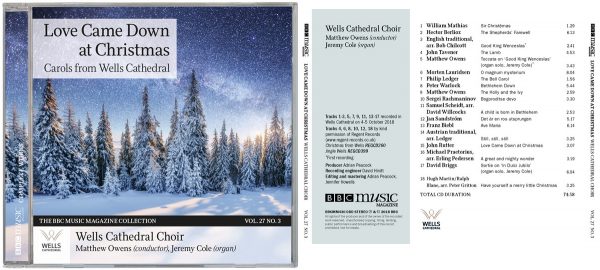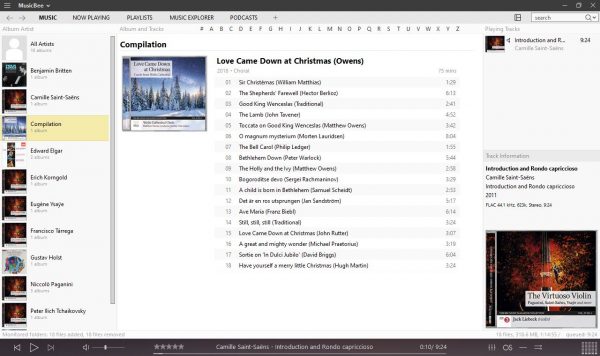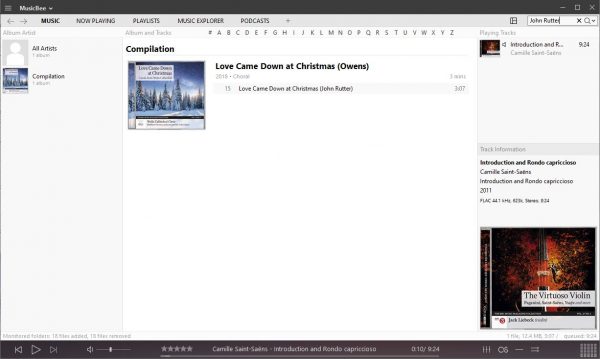1.0 Introduction
This is the fifth article in my series showing how I would suggest you go about the business of ripping and tagging different CDs of varying configurations. Previously, I’ve discussed:
- ripping 1 CD containing 1 composition by a single composer
- ripping 1 CD containing 2 compositions by a single composer
- ripping 1 CD containing multiple compositions by a single composer
- ripping 1 CD containing multiple compositions by multiple composers
In this article, I’m going to discuss how I might go about ripping a single CD containing a bazillion compositions by one or many composers. This is one of the most problematic areas of ripping-and-tagging, because value judgments have to be made -and your approach to making them might not be the same as mine. To illustrate the problem, I'm going to use two CDs as an example of the sorts of decisions you might take.
Firstly, there's this one:
That's 21 tracks all by a single composer as it happens -but the point is that it's lots of compositions, none of which is really significant in its own right. Almost every track falls under my '4 minute rule' (which isn't really a rule, but is discussed in Section 4 of my Axioms of Classical Tagging article) -and the ones which don't cut it pretty fine!
The second CD I'll discuss is this one:
That's a CD containing 18 different tracks that really are by 18 different composers -and, again, a lot of the tracks (but by no means all) fall under the '4 minute rule' threshold and so probably shouldn't be considered 'standalone compositions' in their own right.
I won't be describing the specific point-and-click processes required to rip or tag these CDs, as I think the general principles and practices involved have already been discussed at length in the earlier articles in this series. In this article, I'll concentrate instead on the issues arising when considering how to rip these CDs and what the best outcomes from an appropriate ripping-and-tagging process might be in each case.
2.0 Thinking in the Aggregate
The problem with both these CDs, in other words, is that nothing on either of them really stands out as a composition 'worthy' of being regarded as a separate, standalone 'album' in ripping and tagging terms. In the first case, Britten didn't write something called 'Folksongs'; all 21 tracks were genuinely separate compositions, some as early as 1940, some as late as the 1970s. But no one composition is of sufficient significance to stand on its own two feet and every one of the 21 tracks gets its worth largely by being part of a set of 21.
Putting it yet another way: do you ever sit down and think to yourself, 'I'd like to play O Waly Waly'? Or do you instead think 'I feel like a half-hour of Britten folksongs'? If you want to play things as individual pieces, then catalogue them that way. But if you find the main value of a CD is in listening to it in the aggregate, then catalogue it as a single entity containing lots of tracks. Resist the temptation to remember the exceptions, too, when thinking about how you approach a CD. In my case, I adore The plough boy, Tom Bowling and The bonny Earl o' Moray. There are, in fact, times when I do think, 'I fancy listening to The plough boy', all on its own. But I more generally think in terms of the Folksongs as a collection, so the exceptional factors governing three of them shouldn't blind me to the fact that I usually think of them in the aggregate.
This is also something that effects the Love Came Down at Christmas CD: it's a CD all about Christmas carols and similar choral works which evoke the 'mood' of Christmas -and they do that effectively in the aggregate. Whilst there are a couple of tracks whose length certainly makes them candidates for separate ripping (see track 6, for example, at over 8 minutes long), does it make sense to rip them out into standalone albums and leave the sub-4-minute mass behind as a lump of Christmas-themed short pieces? Your view on that might be different from mine, and that's fine.
If you thought that, say, tracks 6, 8, 13 and 16 should be regarded as significant works in their own right, you're in the same territory as I already discussed in the '1 cd, multiple composers, multiple composers' article. So the steps outlined there should work for you in producing 5 separate 'albums' from the 1 CD (i.e., track 6 on its own; track 8 on its own; track 13 on its own; track 16 on its own; and everything else as a 'Christmas music from Wells' virtual album). I won't say such an approach would be wrong -but in this case, I think tracks 6, 8, 13 and 16 only really get their 'power' by being part of the entire Christmas CD experience. The 'mood' the CD is promoting is more significant than the merit of its individual compositions. This is indeed commonly true of 'mood' or 'themed' CDs: break them apart into separate compositions (i.e., separate 'albums' ) and you diminish the intended effect.
Where you 'feel' the contents a CD in the aggregate, in other words, don't attempt to rip it as a set of separate 'virtual albums', but rip it entire and whole, as a single 'album'.
What you call that one 'album' is then really up to you -though taking the lead from the CD manufacturer/music publisher isn't a bad place to start. "English Folksongs" and "Love Came Down at Christmas" seem like good album names to choose for my two specific examples, in other words.
The real point here is that it's not 100% clear-cut. The decision to 'split into virtual albums' or 'treat as a single CD' is a matter of judgment and the way you approach your music collection. What's right for one person may not be the true for all. As I say, if you like the 'multiple virtual albums' approach, I've already described how to rip and tag those. The remainder of this article is for those occasions when you feel that it's imperative to rip the disk as a single, 'mood' or 'theme' CD.
3.0 Who is the Composer?
The trouble with aggregating multiple, diverse tracks as a single 'album' is that we need to find something to tag the resulting 'virtual album' with an ARTIST and COMPOSER tag -and Axiom 2 says that ARTIST and COMPOSER should always be the same thing.
In the first of my CD examples, this isn't a problem: all 21 tracks on the 'English Folksongs' album I'm about to create were written by Benjamin Britten, so ARTIST and COMPOSER can both be set to Benjamin Britten with a clear conscience. The tagging in that case is not only functional but entirely accurate!
But in the second CD, this does become a problem, since every one of the 18 tracks on our 'Love Came Down at Christmas' album was composed by a different composer -including the dreaded 'traditional'. Who, then, can be set as the ARTIST and COMPOSER? Well, you obviously cannot set it to be 'William Mathias', since that would be wrong for 17 other tracks. Similarly, you can't say it's 'Sergei Rachmaninov'... since that would be wrong for a different set of 17 tracks. In fact, the only possible 'composer' name that would be valid for all 18 tracks is one that never actually lived: Compilation.
Some people prefer the words 'Various Artists' to be used in this situation. However, I feel this wording implies that we still care about the individual composers or 'artists' when, in fact, we've given up caring about them at this point. I mean only that we are currently thinking about how to tag things at the album level -and at that level, we simply don't have a real, genuine value for ARTIST or COMPOSER that we can supply -so rather than use wording that implies that somehow we care about the 'Artist' at this album level, we would be better off (I think) making a clear declaration that we've got an album which is merely a compilation of works by multiple people, none of whom we can meaningfully identify individually at this level of tagging. I would therefore strongly recommend not to use the 'Various Artists' tag.
4.0 Forget the Composer entirely?
Despite what I've just said, however, I am reluctant to forget the composers entirely. They lived (and usually died!) to give us the benefit of their artistic vision, after all. Just ignoring their existence seems a tad ungrateful!
Accordingly, when you declare the composer/artist to be "Compilation", I would argue that the composer's name should nevertheless be included in the TITLE tag for each track. This is a breach of normal tagging protocol in a sense: we normally use the composer name only in the ARTIST and COMPOSER tag, which applies album-wide; and because it's generally bad form to repeat the same data at multiple levels, we usually do not include the composer's name in the TITLE tag. In this case, however, since we have not specified the real composer's name at the album level, the 'rule of no repeating' would not be violated if we now mentioned the composer's name in the TITLE tag.
For the sake of consistency, I would suggest we use the composers' full names in the TITLE tag of a compilation CD: we have used composer's full names in all previous tagging efforts, so let's do likewise now. For the sake of efficiency, I would suggest tacking it in brackets at the end of the TITLE: when you are trying to read the name of works on a small screen (such as a smartphone) you don't want it to read William Matthias: Si...but Sir Christemas (Wil... In other words, where screen real estate is limited, the name of the song is more important to read than its composer (I would suggest), therefore put the song name up-front and relegate the composer's name to the end. Although this might restrict the ability to display a composer's name, it will in fact still be searchable by most music player/managers search capabilities (so a search for all of William Matthias' work will pick up things tagged as ARTIST=William Matthias as well as things tagged as ARTIST=Compilation, TITLE=anything (William Matthias)).
5.0 Worked Examples
With those considerations out of the way, here's how I would tag each of these CDs in turn:
Here you can see another of my last-minute changes of mind: I decided to call this album just 'Folksongs' rather than 'English Folksongs', because I finally noticed tracks 12 and 13 are actually two Britten settings of French folksongs: it pays to be precise in these things! I've mentioned Peter Pears as the 'distinguishing artist', since he's doing the singing -but you could just as easily argue for '(Britten)', as he's doing the piano playing: that's another matter of personal preference. Also note that I used different album art from what I originally showed you. The album art at the top of this article is what was actually shipped with my CD, but it's a generic picture of someone ploughing a field and therefore has practically no relevance to the actual content of the CD, except for the fact that the last track on it (and perhaps Britten's most famous folk-song setting) is called The plough boy! When I first got these songs on ye ancient vinyl LP, the cover showed Britten at the piano with Pears looking in from the right: it's more informative, and something I'm also more familiar with, through decades of long usage. So I decided to stick to the album art that made sense to me -yet another matter for personal preference.
You can see that I've simply numbered all tracks 1 to 21, sequentially, all attributed to the named composer (and therefore artist), Benjamin Britten. Accordingly, this CD appears as follows in my media player/manager:
Highlight Benjamin Britten in the left panel, his Folksongs CD then appears, as a single 'collection' or 'compilation', but attributed to the single composer he actually was, by name.
Now for the next CD:
Here, you see all tracks tagged up with ARTIST and COMPOSER set to Compilation, as previously discussed and (at length!) agreed.
As well as that, I've opted to tag everything as belonging to the single album called "Love Came Down at Christmas (Owens)", where Matthew Owens as conductor of the Wells Cathedral Choir has been used as the 'distinguishing artist'. You might have chosen to tag it up with '(Wells)' or '(Wells Cathedral Choir)' as the distinguishing artist, because you regard Wells Cathedral Choir as being of more significance as a differentiator for these works than Matthew Owens: there's no right or wrong to that sort of decision.
The other thing I wanted to draw your attention to: all the track composers are nicely identifiable at the end of the TITLE tags... but I draw the line at mentioning arrangers! Thus 'English Traditional arranged by Bob Chilcott' (for track 3) has been rendered merely as 'Traditional': sorry Bob, but a bit of arranging of someone else's original work doesn't warrant a mention in my music catalogue, I'm afraid! Along similar lines (though you won't be able to tell from the screenshot), I am not keen on joint compositions, so track 18, written (according to the CD cover and Wikipedia!) by Hugh Martin and Ralph Blane simply gets attributed to 'Hugh Martin' here. There's no particular rhyme or reason to that, except that my music catalogue is supposed to be a set of usable and meaningful music facts, not a comprehensive encyclopedia of truth. A double-composer in brackets at the end of an already long track name is just less functional to me than a bit of careful abbreviation of the facts!
The net effect of this ripping and tagging exercise is seen here:
The composer is 'Compilation'; the CD is preserved in its 'mood-setting' entirety as a single album; the individual bits of music remain searchable by composer nonetheless. If I search for everything I've got written by, say, John Rutter:
...then my music manager is clearly able to detect his name in the TITLE tag as successfully as it would have if he had been named as the ARTIST or COMPOSER of the piece. So, core search functionality has not been compromised by this slightly peculiar use of the 'Compilation' composer, which is a key point.
6.0 Conclusion
The main thing to get out of this article is that whenever you are confronted with a CD containing a lot of tracks which are not intrinsically linked -whether by a single composer or not- you have to make a decision about whether to rip the separate works separately or whether to regard them in the aggregate, and rip the CD as a single entity. If you're going to rip as separate works, see the 'multiple compositions' articles in this series to work out how to proceed, depending on whether a single or multiple composers are involved.
If, however, you feel that the separate works only get their 'oomph' by being part of an aggregated collection, such that ripping them all as a single album is the more appropriate approach to take, then you have to handle the COMPOSER/ARTIST issue: if the entire CD can be attributed to a single, 'real' composer, then do that and assign an ALBUM tag that neatly and concisely describes the entire collection of works (which may or may not be what the music publisher stuck on the front of the CD booklet!)
Where multiple 'real' composers wrote different tracks within the aggregate, you then are dealing with a 'compilation CD' and should therefore attribute the COMPOSER/ARTIST to Compilation. At that point, you won't have a 'real' composer at the album level, so it's appropriate instead to mention the real composers in the TITLE tags for each separate track, in a way that doesn't compromise concision or search functionality.
Back to the Master Index of the Guides to Ripping and Tagging






